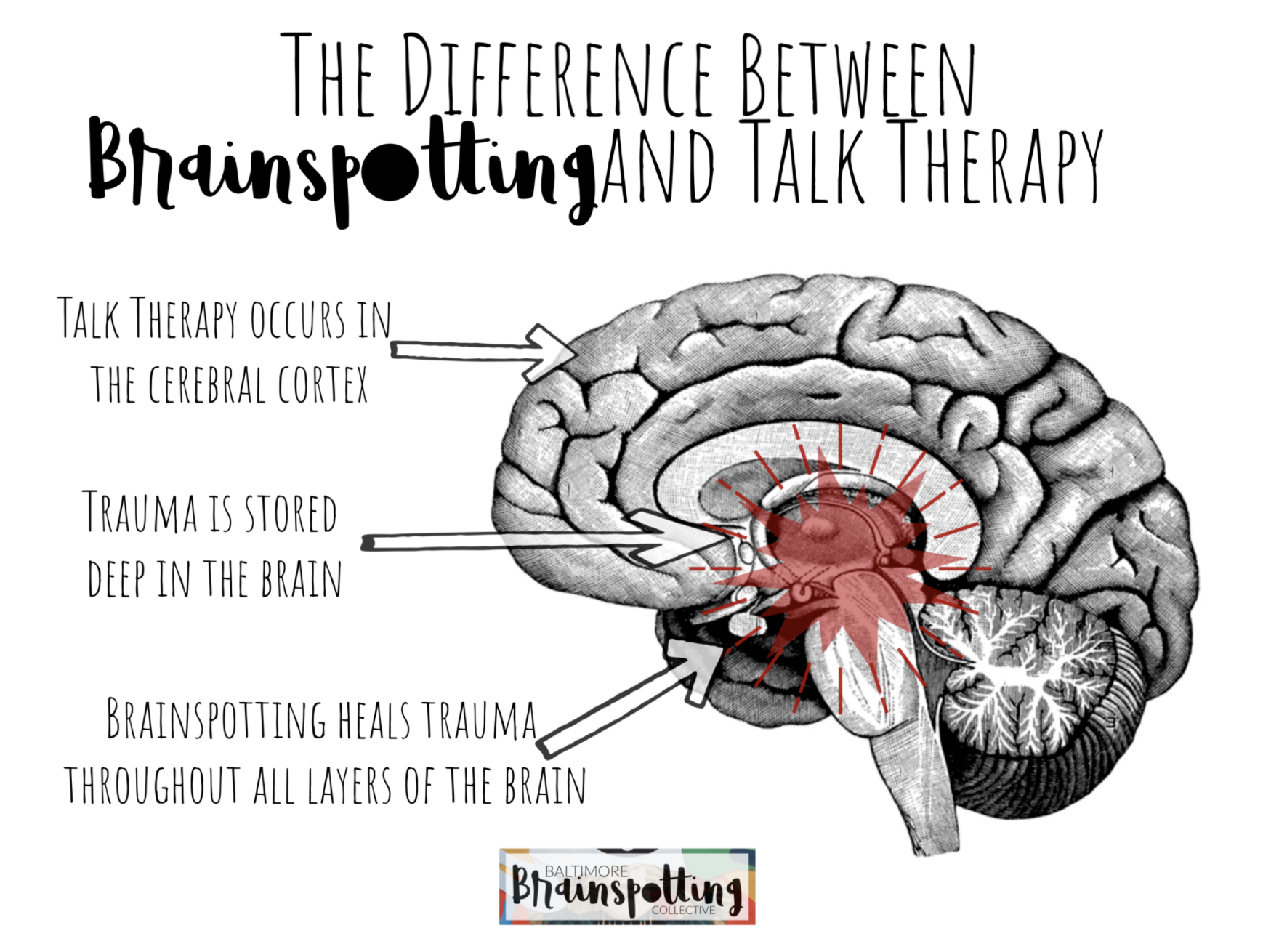Brainspotting vs. EMDR
Brainspotting and EMDR are both cutting-edge psychotherapeutic modalities for effective trauma treatment, with distinct methods for accessing and healing emotional wounds, and are increasingly gaining attention in Baltimore, MD. Brainspotting employs the visual field to tap into where trauma is stored in the brain, guided by the belief that where you look affects how you feel. In contrast, EMDR utilizes bilateral stimulation, like eye movements or auditory tones, to help the brain desensitize and reprocess traumatic memories within a structured framework. Brainspotting is often characterized as more fluid and client-led, while EMDR is methodical and therapist-directed. Selecting between the two may come down to individual preferences, the type of trauma being addressed, and one's response to the therapy's approach in the context of Baltimore's diverse therapeutic community. For a deeper dive into these transformative therapies, see below to learn more.
Unlocking Healing from Trauma: Exploring Subcortical Therapies Beyond Traditional Talk Therapy
Do you feel like you are talking yourself in circles in therapy, and still not making the progress you had wanted?
You may have analyzed your family of origin wounds, past painful experiences, and become aware of the thoughts, beliefs, actions, and patterns that no longer serve you, and yet you still feel stuck.
The truth is, there are some issues that we cannot simply talk ourselves out of. The part of our brain that thinks in verbal language and uses logic to solve problems (the neocortex) is distinct from the area of our brain where we process emotions (the subcortex).
This means that in order to move past deep-seated trauma and other difficult emotional wounds, we must intervene on the physical and emotional subcortical level as well as on the logical, neocortical level, a realization that is gaining recognition among therapists and clients alike in Baltimore, MD.
Enter Brainspotting (BSP) and Eye Movement Desensitization and Reprocessing (EMDR) Therapy
Both are evidence-based modalities that facilitate subcortical emotional processing and help you see stored information in a new light. Learn more about each modality + how to decide which one may be right for you, below.
Brainspotting
Brainspotting (BSP) is a relatively new therapy that was actually discovered by David Grand, Ph.D. during a modified EMDR session. The main premise is this - “where you look affects how you feel.”
It may sound a little far out, but researchers have long been investigating the link between eye movement and position and emotional processing.
A Brainspot is a point in your visual field that is deeply connected with painful emotions or issues that you can’t seem to get past. A skilled BSP clinician will help you locate your Brainspots by using a pointer to guide your gaze while playing Bilateral sounds that stimulate both sides of the brain. Simultaneously, the Brainspotting clinician will carefully watch your physical responses as you either talk through or think about a troubling issue or feeling. When the pointer comes across a Brainspot, the deep brain will reflexively signal to the therapist that a Brainspot has been found.
These reflexive signals often happen below the level of conscious awareness and can include an eye twitch, facial tic or microexpression, a furrowed brow or change in pupil dilation, a swallow, yawn, cough, foot movement, or any other physical shift in your body.
Once a Brainspot is identified, your therapist will hold your eye position on the spot while you focus on the emotional process and physical sensations being accessed. This can be an intense experience, and for this reason, you will learn and practice some coping skills with your therapist before you start working with your Brainspots - skills like breathing exercises, bilateral stimulation, compassionate self-talk + affirmation, visualization, and calming imagery.
EMDR
Eye Movement Desensitization and Reprocessing (EMDR) is a highly structured treatment protocol that has been helping clients move through trauma for over 25 years.
EMDR always starts with a history-taking session where you will share details about your childhood and upbringing, including a general trauma history + information about your current context and relationships.
As in BSP, you and your therapist will also identify and practice coping skills in the first few sessions that you can use to soothe yourself when you begin to process your painful memories in future sessions.
In the next phases of EMDR, you will tell the story of a specific painful or traumatic memory in vivid detail, facilitated by bilateral stimulation from handheld tappers, lateral eye movement, and/or audio. Through this process, you will verbalize any negative beliefs about yourself that you notice, internalize more helpful core beliefs of your choosing, process any emotions that come up, and find closure.
When deciding which modality you’d like to try, consider how you’d like to process, and what level of structure you prefer.
How do you want to process?
When it comes to processing trauma and painful emotional wounds, there are generally two approaches:
Top-Down Processing involves talking about your experiences and feelings and gaining cognitive insight.Bottom-Up Processing involves having corrective emotional experiences in the body that contradict your painful experiences.
Bottom-UP
In Brainspotting, we generally spend more time in bottom-up processing than we do in top-down. The emphasis is more so on your emotional experience as it shows up in your body during the Brainspotting scan, and less so on the details and cognitive insight.
While you are free to share any details, images, and insights that come up during Brainspotting, and it might be very healing to allow some of this top-down processing to occur if you feel safe, it’s not required that you talk about your memories and core beliefs in detail order for your subcortical emotional process to occur.
During the Brainspotting scan, your therapist will track your eye gaze while you are given the option to either talk out loud or think internally about your issue or memory.
This makes Brainspotting a great option for folks who, for a variety of reasons, may not be willing or able to talk about all the details of their trauma with a therapist, including:
Folks who’ve been in therapy before and may not want to go through the whole schpiel of recounting their trauma again with another therapist.
Those who have tried to find wellness through a more cognitive approach, and are ready to try another strategy to move through their emotional wounds.
Those who have experienced any type of complex trauma including but not limited to racial trauma, trauma related to gender or sexual identity, chronic health concerns, toxic family environments and relationships, and trauma related to being neurodivergent in a neurotypical world.
It can be difficult to gain insight into these experiences from the inside, to rewrite negative core beliefs when they are being constantly reinforced by a sick society, and to find closure when the trauma is still ongoing (all elements of EMDR, but not required for BSP.)
Folks with non-conventional language abilities.
Top-down + Bottom-up
On the other hand, EMDR is a useful modality for folks looking to process specific traumatic experiences, memories, and relationships through a mix of bottom-up and top-down processing.
EMDR targets both the emotional subcortical brain and the logical neocortex with all the stories it’s created about you, others, and the world around you. In that way, EMDR is great for folks who are looking to re-story themselves and create a more compassionate narrative about themselves and the world around them.
do you prefer structure or spontaneity?
If you prefer structure…
EMDR is a highly structured 8-phase protocol. While it’s impossible to predict what it will be like as you process your trauma, the EMDR protocol is like a roadmap to help guide the uncertain process.
Phase 1 may take 1-2 sessions and generally involves getting a detailed history of your case and identifying the “targets” of therapy. These targets may be specific experiences, memories, and relationships.
In Phase 2, which could take anywhere from 1-4 sessions, you will learn more about EMDR, build rapport with your therapist, and learn coping skills that you can use to regulate your emotions as you process in later phases.
In Phase 3 you will begin to identify negative core beliefs related to the targets you chose to process. You will also identify more positive beliefs that you would like to hold instead.
Phase 4 involves the use of some form of bilateral stimulation as you process the feelings and sensations related to your target memory and memories associated with it. During this phase, the goal is for your emotional response to the details of your traumatic experience to get less and less intense as you expose yourself to the details and allow yourself to move through the difficult feelings that surface.
The goal of Phase 5 is to focus on the positive beliefs you identified in Phase 3 until you begin to internalize and believe them. This can take a little time!
In Phase 6 you will again talk and think about the details of your traumatic experience, and the goal is that you reach a point where you can talk about it without any tension in your body. It should no longer be emotionally triggering and painful to think and talk about your memory.
Phase 7 involves closure, which is a part of each EMDR session. The goal is for you to leave the session regulated and feeling safe.
Finally, Phase 8 is the reevaluation phase - you and your therapist will review your targets and therapeutic goals and assess whether termination is appropriate or whether further work is necessary.
If you prefer spontaneity…
Brainpostting is an intuitive and flexible method. A skilled Brainspotter is more interested in attuning to your experience and facilitating your emotional process in a safe and paced way than they are in following a structured session protocol to the T. Since we all move at our own pace, BSP will look slightly different depending on each unique client’s temperament and circumstances.
Although Brainspotting is flexible, there are a few constants:
Brainspotting works by attuning to the brain’s autonomic and limbic systems, located within the central nervous system.
Brainspotting usually involves the use of bilateral stimulation, commonly in the form of bilateral sounds, to assist in creating the “trance state” which is optimal for subcortical emotional processing.
Before beginning the emotional work of Brainspotting, your therapist will ensure that you have the coping skills needed to process the emotions accessed by your Brainspots.
Your therapist’s job, first and foremost, is to attune to your emotional state and pace the session so that you do not get overly dysregulated. If at any time Brainspotting feels too overwhelming, do let your therapist know, and they will stop working on that spot and switch the focus back onto regulation.
Because Brainspotting can be such a powerful emotional experience, your Brainspotting clinician at Space Between Counseling Services will check in on you with a phone call and/or email, depending on what you prefer, within a week of your session to make sure you are doing well and arrange for any follow-up care if necessary.
Most people come to Brainspotting for 3 to 9 sessions, depending on the severity of past trauma + individual goals, and Brainspotting is commonly used as an adjunct or addition to regular talk therapy.
Both EMDR and Brainspotting are evidence-based modalities that can help you get past a wide variety of emotional issues, including trauma, depression, anxiety, negative self-esteem + self-worth, addiction, and more. Consider your unique needs and preferences before making a decision.
INTERESTED IN Learning more or trying BRAINSPOTTING FOR YOURSELF?
Meet the Team of Brainspotting Clinicians at Space Between Counseling Services:
Susan Stork, LCPC, LPCC, LPC, CST
Phases 1- 4 Brainspotting Clinician
Diana Harden, LCPC
Phase 1 Brainspotting Clinician









